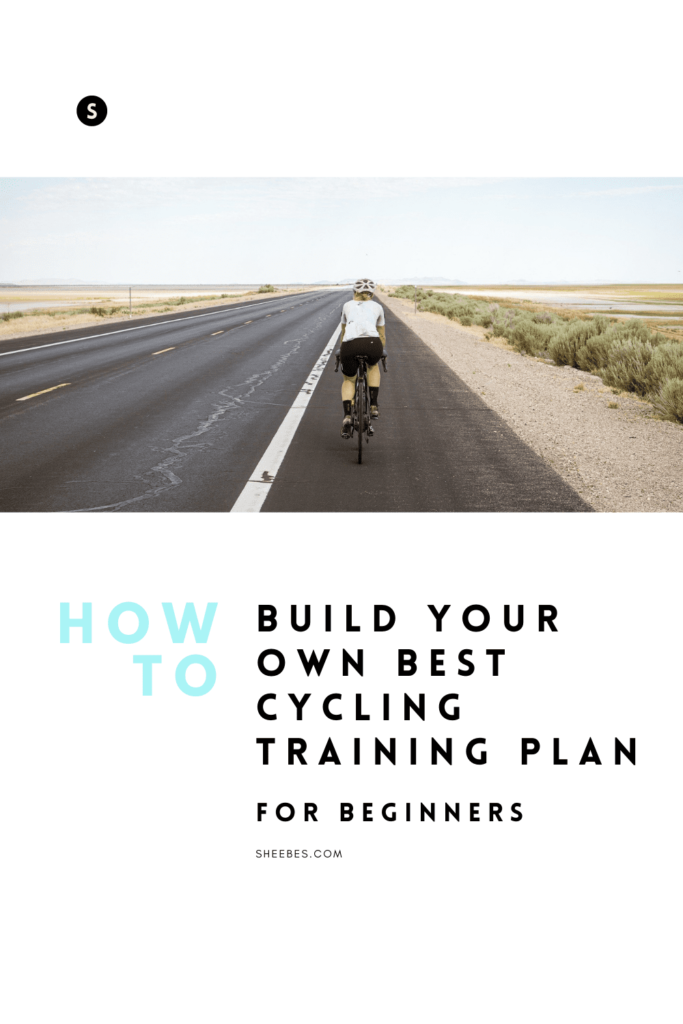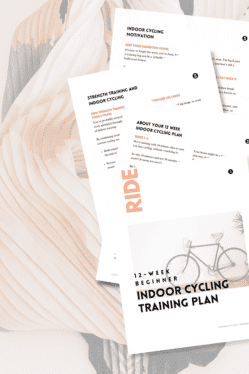How do you start building a cycling training plan when you’re brand new to cycling?
You know that having a cycling training plan can give you some structure, boost your cycling fitness, and keep you motivated if only you knew how to create one.
Should you ride your bike every day?
Should you ride your bike for miles and miles?
What should you do to build your endurance and fitness on your bike?
If you’ve got all your cycling essentials and you’re ready to begin crafting your cycling training plan, then you’re in the right spot.
We’ll jump right into the framework of a cycling training plan for beginners and all the details you need to know today.

Whether you’re a runner looking for running tips or a cyclist searching for cycling advice, this site is here to help you elevate your fitness game.

Affiliate Disclosure: I’m here to help you grow as a rider and runner. So to keep things running smoothly and the content free, I participate in the Amazon Services program and select affiliate networks. So, when you click on those affiliate links, I earn a small commission at no extra cost to you.
HOW TO BUILD A CYCLING TRAINING PLAN (FOR BEGINNERS)
Before we dive into the details of building a cycling training plan. The general framework for your cycling training plan will look like this:
- Ride your bike 3 days a week, every other day
- Do one long bike ride on the weekend
- Rest or cross-train on days when you aren’t cycling
- Each week, increase your total mileage by 10% a week
- Every 3 to 4 weeks, take a rest week

Ride your bike three days a week
Easy-paced bike rides build strength in your muscles and build your aerobic system without overstressing your body.
Though you’ll ride your bike three days a week (if your schedule will allow it), you’ll need to add rest days in between each bike ride. (More on rest days below.)
That’s because we’re trying to strike a balance between stress (that’s your cycling) and rest, so you don’t get hurt.
Time-saving cycling tip: If you haven’t established a consistent cycling routine yet, you’ll soon find that even short outdoor bike rides devour your valuable time.
Gathering your gear, getting your bike ready to ride, and driving to a bike trail, can tack on another hour to your total bike time.
So if all of that sounds like it’s going to take too much time, try indoor cycling.
If you have space, leave your bike on your indoor trainer, so all you have to do is slide into the saddle, cutting out the time it takes to get organized and drive to a bike trail.

Do a long(er) ride on the weekend
Most cyclists go on long rides on the weekends (or on their days off) because that’s when most people have the most time.
Long easy paced rides, like weekday rides, are meant to boost your endurance. But they don’t have a set length; they’re just lengthier than any other ride that you’ve done that week.
On these long rides, you’ll learn more vital cycling skills:
- Mental toughness. Can you push yourself to ride a distance you haven’t before? Can you stay focused for a long ride?
- Fueling on the bike. What are the foods that will work for you? Can you take your hands off your handlebars to grab your water bottle?

12 WEEK BEGINNER INDOOR CYCLING TRAINING PLAN
$20
DETAILS
This beginner indoor cycling training plan is perfect for busy beginners craving a gentle start to a consistent cycling routine.
Go from an absolute beginner to cycling 60 minutes nonstop with this 12-week indoor cycling workout plan.

Rest or cross-train on non-cycling days
Rest days help you absorb your training by taking the stress of cycling off your body to help it heal and rebuild muscle.
Though you could take the day off, cross-training with strength work is a great option for cycling.
With regular strength training, you’ll:
- Build your muscle strength (so that you’ll have energy throughout your entire bike ride)
- Prevent chronic injury
- Gain stability and mobility
Do you have questions about what exercises to do and how to combine strength training with cycling? This post on strength training for cyclists can help.

Increase the time on your bike by about 10% a week
You don’t want sudden spikes in your cycling time—that’s a recipe for getting hurt.
Remember, cycling is a form of stress on your body, so you want to give yourself as much time as possible to adjust to this new stressor.
So to do this, we want to develop your fitness slowly and steadily by extending the time you spend on your bike by around 10% a week.

Take a rest week every 3 to 4 weeks
Recovery weeks, like rest days, allow your body to relax and repair itself.
Recovery weeks do not mean that you’ll have total time off (though you could do that).
You’ll cut about 30% of the time you usually spend on your bike so that you can recover without detraining.
These recovery weeks aren’t only physical—they’re there for a mental breather, too. You get to reflect on what you’ve done so far and look ahead to see where you want to take your training.

Take it to the next level
You’ll soon bump into the maximum amount of time you can spend cycling.
So rather than try to spend even more time in the bike saddle, here’s where you’ll bump up your intensity.
And you can do that with:
- Tempo rides
- Interval efforts, such as HIIT cycling workouts and hill climbs
- Sprints to build your explosive power and speed.
CONCLUSION
I hope this cycling training plan for beginners framework has given you a head start on crafting your training plan.
But if you’re new to cycling and would rather have a ready-made cycling training plan, I’ve created an indoor cycling plan you can snag!

12 WEEK BEGINNER INDOOR CYCLING TRAINING PLAN
$20
DETAILS
This beginner indoor cycling training plan is perfect for busy beginners craving a gentle start to a consistent cycling routine.
Go from an absolute beginner to cycling 60 minutes nonstop with this 12-week indoor cycling workout plan.